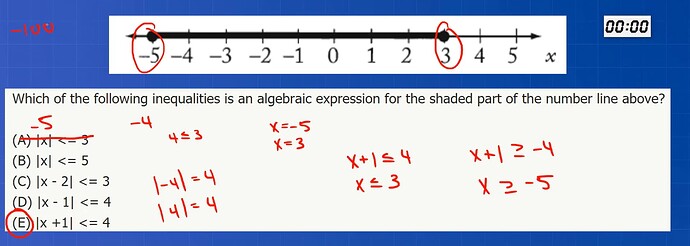I don’t understand how B) is not a correct answer. Absolute value of -5 is less than or equal to 5. Absolute value of 3 is less than or equal to 5. When you switch the equation of B) to be greater than or equal to negative 5, again - absolute of -5 is greater than or equal to negative 5, absolute value of -3 is greater than or equal to negative 5. Making it true.
Greg uses -100 as an example for B but I do not understand where that number came from when the number line depicts the range being -5 to 3.
First you have little misunderstanding in absolute equation. Let’s say |x| = 5 then we know that x has two values 5, -5. So, when you plot this at line, you will have two black dots paced in 5, -5.
Now look at question if b was answer you should have one black dot at 5 which is obviously not there it is at 3. So, we can directly ignore that answer you have deemed true.
Answer is E because that equation will form 2 regular equations 1) x + 1 <=4 i.e. x <=3 which exactly shows that x can be 3 or less than 3 so black dot should be at point 3 and moves left.
2) -(x + 1) <=4 i.e. x+1 >= -4 and x >=-5 . here we are just multiplying equation by -1 which flips the sign, and we know x is -5 and greater than -5, which means black dot must be at -5 and moves to right.
You have to review your understanding of Absolute Value and also how absolute value can be drawn on a line.
